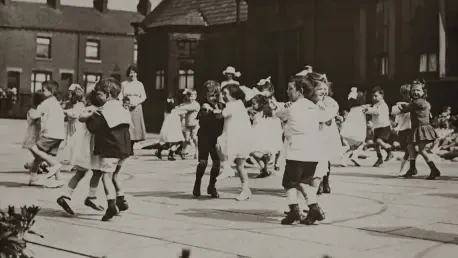Established in 1875, a year before Pease Elementary, Summitt School stands as one of the most enduring educational institutions in Austin, Texas. For 150 years, it has mirrored the city’s evolution, growing from a modest one-room log cabin into a modern elementary school. Positioned initially on Burnet Road, it underwent multiple relocations, reflecting an adaptability vital to its legacy. In 1986, it settled at its current location on Brigadoon Lane. Throughout its existence, Summitt has not only adapted architecturally but also embodied the broader societal shifts around it, including the profound impacts of segregation and educational reform, thus serving as a microcosm of American educational history.
Beginnings and Early Evolution
The establishment of Summitt School was a testament to the growth of rural education in Texas. Initially designed to cater to the educational needs of the local farming community, it started as a small log cabin on Burnet Road. Unlike other institutions like Pease Elementary, Summitt did not maintain its original structure. Instead, it underwent numerous renovations and relocations, signifying a pattern of resilience and adaptability. Over the years, the school continually updated its facilities to meet increasing demands and changing educational standards.
Historic accounts and archival records reveal that by the early 20th century, Summitt School had already played a significant role in consolidating rural education. The discussion of consolidating rural schools was first noted in the “Austin Statesman” on July 4, 1905. However, despite sporadic mentions over the next two decades, the school largely remained out of the limelight. This oversight in mainstream narratives emphasized the invisibility of rural schooling during that era. Despite these challenges, Summitt School persevered, even escaping the widespread impacts of the 1918 Spanish Flu, as reported by Principal Eunice Baker.
Architectural Developments and Challenges
Significant transformations occurred in 1954 when a new Summitt School building was constructed at Burnet Road and Kramer Lane. Designed by Page, Southerland, and Page, and built by C. Ben Hibbetts Construction Company, this modern establishment replaced an earlier structure. Unfortunately, despite its modernity, the facility faced vandalism issues; in 1958, over 80 window panes were damaged. This incident highlighted the ongoing challenges rural schools faced in maintaining infrastructure amid limited resources and external threats. Such adversities, however, did not deter Summitt’s determination to excel and serve its community.
Further change came in 1986 when Summitt was relocated to Brigadoon Lane. This move marked yet another chapter in the school’s history of change. Head teacher Allan Gray’s pragmatic acceptance of the frequent closures and openings summarized the school’s adaptable spirit and a community accustomed to embracing new beginnings. At Brigadoon Lane, Summitt School found a more stable environment, which allowed it to focus on nurturing strong educational values and community ties, aspects crucial to its enduring legacy.
Societal Shifts and Integrations
The sociocultural landscape in which Summitt School existed was profoundly shaped by broader societal changes. Journalist Michael Mixerr’s historical exploration sheds light on the initial existence of separate educational paths, illustrating demographic divides of the era. The school’s segregated history, with separate facilities for white and African American students, mirrored national racial tensions and inequalities. However, as societal reforms took root, Summitt adapted to these changes, merging schools and broadening educational access to align with emerging principles of equality.
Significant structural consolidations were pivotal in this transformation. The 1915 merger with Waters Park School and subsequent consolidation with Fiskville School in the 1950s marked strategic efforts to pool resources and better serve the community’s educational needs. In 1960, integration into the Austin Independent School District was realized following a successful vote, which marked a crucial step toward inclusivity and expanded educational opportunities for all students. This approval signified a turning point where Summitt fully embraced Austin’s urban educational framework.
Personal Narratives and Community Engagement
Adding a personal dimension to the Summitt School story are recollections from former students such as Anna Galloway, who attended from 1946 onwards. Through her memories, the vibrant yet simple joys of small-town school life are vividly detailed. She recalls an environment where children’s education was enriched by playground activities and social interactions, forming the crux of educational experiences then. The absence of a school mascot or team colors underscores the community-centered focus that defined Summitt’s culture and ethos.
The Summitt School community remained united and strong through the school’s various iterations, including the demolition of its Burnet Road and Kramer Lane building in 2003, replaced by a shopping center. This was yet another manifestation of urban redevelopment that continues to repurpose educational properties. Yet, despite these changes, the spirit of the Summitt community lives on, captured in initiatives such as the fifth-grade project “100 Golden Years.” This project serves as both a testament to Summitt’s rich history and a beacon for its future legacy within the educational landscape.
Reflection and Future Considerations
Summitt School, established in 1875, holds the distinction of being one of Austin, Texas’s most time-honored educational establishments. Opened a year prior to Pease Elementary, it has faithfully reflected the city’s transformation. Originally a simple one-room log cabin, it has evolved into a state-of-the-art elementary school, representing the growth of Austin itself. The school’s journey began on Burnet Road, and it relocated several times before settling in 1986 at its current venue on Brigadoon Lane. This movement signifies the school’s dynamic nature and adaptability, crucial traits contributing to its enduring legacy. Over its century-and-a-half existence, Summitt School has not only changed structurally but also mirrored societal changes, like the challenges and impacts of segregation and subsequent educational reforms. It serves as a microcosm of broader educational history in America, illustrating the shifts and advancements in the American educational landscape over the decades.









